EBOOK
The Ultimate Guide to Customer Database Growth
Published: Nov 16, 2017
What you’ll get from this guide
What’s unglamorous, unsexy, and old school…but also one of the most effective digital marketing channels around? Here’s a hint: Email automation company Campaign Monitor reported a $44 return on every $1 spent on email (up from $38 in 2015 and $34 in 2014).
Yep, the humble email is still one of the most effective ways to reach your customers.

A message is five times more likely to be seen in an email than via Facebook. Customers are fans of email too: 72% of people prefer to receive promotional content through email, compared to 17% who prefer social media.
As if you needed any more reasons to invest in customer database growth, according to McKinsey, the average value of an order that originates from email is at least three times higher than one that comes from social media.
So while eCommerce retailers should be continuously optimizing their sites for sales conversions, a secondary conversion aim should be to acquire a visitor’s email (we like to call this a micro-conversion).
After all, not everyone’s ready to buy straight away – by capturing their email address, you open the door to nurturing them into a position where they’re ready for that macro conversion.
The need to focus on customer database growth becomes even more important given that in a newly privacy-conscious world, consumers are more cautious than ever before when it comes to handing over their data. In the wake of GDPR, marketing databases have suffered, with more than one-third of marketers (33.4%) reporting losses of 30% or more.
But it’s not all doom and gloom, the study into the impact of GDPR on marketing databases also found that those who employed smart (and compliant) lead generation strategies (like the ones in this guide) demonstrated a remarkable recovery when it came to customer database growth one year on:
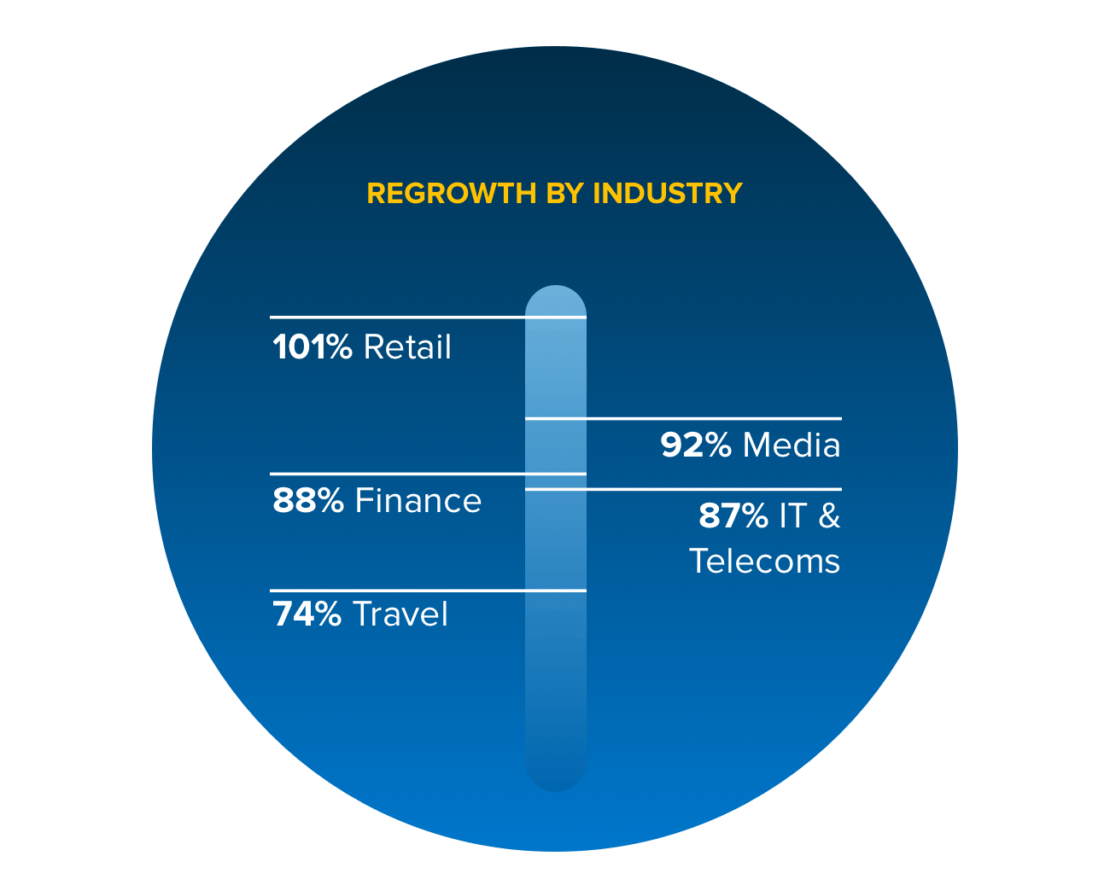
This guide is all about how you can get your visitors to become a subscriber.
In it, you’ll learn the right approaches to acquiring more email addresses from your traffic – from the right incentives to the right moments – while avoiding the potential pitfalls that can come from being too aggressive.
Let’s get started on growing that customer database…
When to ask
As with most things, asking for an email address is all in the timing. While many websites are aggressive in chasing email sign-ups, sometimes asking for an email before visitors have had the chance to read more than a headline, it’s much more effective to trigger an email sign-up prompt once the customer has demonstrated an interest in your brand.
In our experience, visitors are 2.5 times more likely to sign up to your mailing list when they have engaged with the site, compared to when they first enter the site.
See clothing retailer Anthropologie:
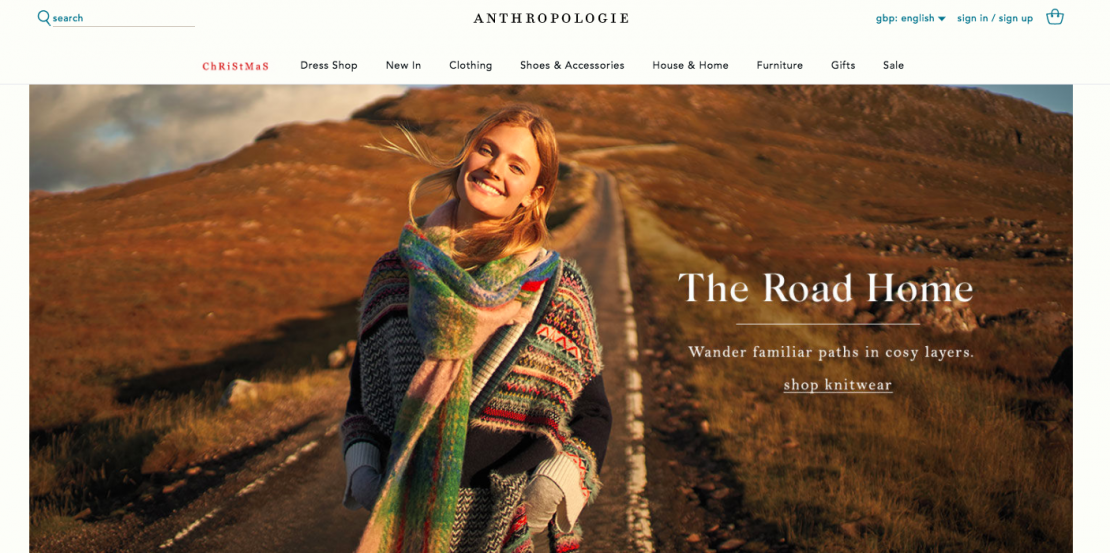
The primary CTA, ‘shop knitwear’, is very clear and the main focus of the front page – there’s only a very small ‘Sign Up’ button in the top right. The email CTA doesn’t appear until you’re browsing the collection itself:
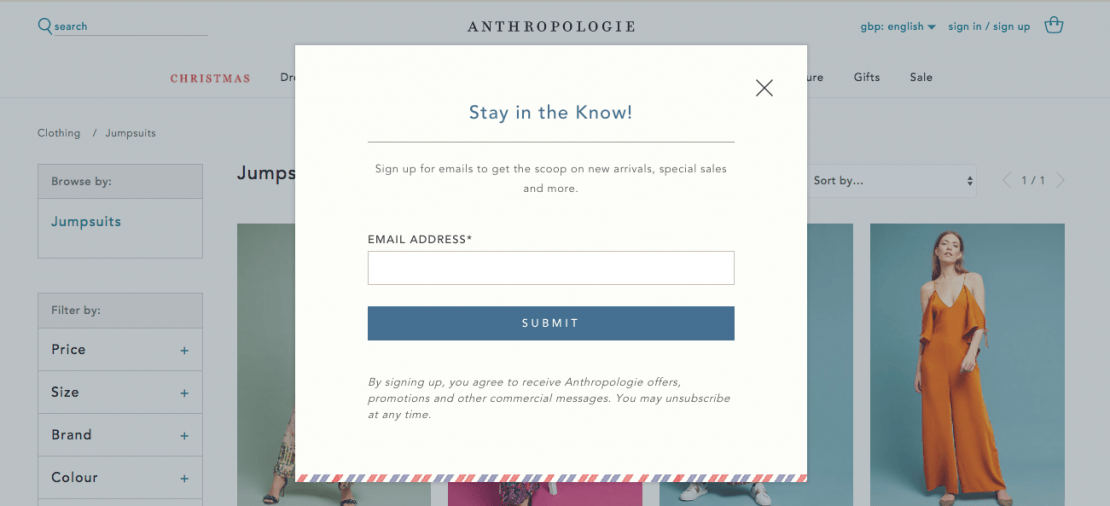
The key thing here is that the brand has waited not only until the visitor is deeper into the site, but also while they’re dwelling. We’ve seen a 7.5% conversion rate increase in asking visitors to sign up to email lists whilst they’re dwelling on a page. This is because they’re likely to be reading content or making a decision, interacting with your products, and becoming familiar with your brand.
An email sign-up at the right time can also lead to an increase in the conversion rate for new visitors (up to a 54% average conversion rate uplift), as they are given the nudge they need to make their first purchase at just the right time.
Many brands make the mistake of pushing for an email sign-up the minute a customer lands on the site. We liken this to asking someone for their number two seconds after you’ve met – it’s an overly aggressive approach, and while it might yield some results for your customer database growth it comes at the cost of your customer experience.
Who to ask
As we’ve already mentioned, asking someone for their email address is a step to take once they’ve shown some interest in your offering – you’ll get much better engagement and a much clearer understanding of what individual customers are interested in.
Next, you’ll want to think about who you’re asking in order to make your CTA as compelling as possible – particularly if you’re thinking about an incentive (we’ll come to that a little later in this book).
First of all, you’ll want to filter out anyone who’s already subscribed – there’s no point interrupting their journey and foregoing other potential CTAs to capture an email address that you already have.
Second, you could think about how you can segment your visitors by where they’ve arrived at your site from. For example, if you’re running a PPC campaign around a holiday sale, you could target these new visitors with a sign-up opportunity to be the first to hear about upcoming sales.
Third, think about how you can adapt that CTA depending on the area of your site in which you present it. If we’ve just seen traffic source used as an indicator of interest and intent, segmenting your site is another way of getting that information. For example, someone browsing a product page is more engaged than someone who doesn’t get further than a category page – how would you differ your CTAs to engage those varying levels of intent?
How to ask
Your ideal lead generation CTA will evolve over time and with testing, but there are some fundamentals to consider along the way:
Call-to-action clarity
‘Buy now!’ ‘Click here!’ ‘Check this out!’ ‘Sign up now!’ ‘Shop the look!’
Effective calls-to-action are essential prompts along the customer journey, creating a sense of urgency and directing the actions of the consumer. But they have to be used strategically to get the maximum effect.
Too many calls to action can be confusing and ultimately off-putting for visitors to your site – after all, too much choice leads to inaction. CTAs are a way to guide your visitors gently through their customer journey – too many and you risk your customers feeling shouted at from every angle.
It’s important that your email capture CTA isn’t just creating more noise – it should offer something valuable and be integrated in a way that’s not interrupting the customer journey.
Using a permanent sign-up button
If you’re designing your page to include a sign-up form, consider the placement of your sign-up button. Kissmetrics reports that one retailer gained a 30% uplift in sign-ups (and a 27% increase in revenue!) by putting their form above the fold.
Static field vs targeted pop-up
With lead generation tools like Yieldify, you can trigger an email capture overlay or notification according to very specific user behavior, whether that’s intent to leave, interacting with deeper content, or dwelling on a checkout page. This means you can tailor your creative and CTA to meet different customer needs and profiles.
For example, one Yieldify client recently tested a dynamic design vs a static design and found that users were almost twice as likely to enter their email address when the creative was dynamic.
Avoiding being ‘pushy’
The eternal conundrum: where’s the line between persistent and pushy? It can be hard to know what will turn an interested browser into a bounce, so once again, laser-focused analysis of user behavior and testing will give you the answer that’s specific to your customers’ needs at the time.
What to offer
As we’ve already covered, emails are a valuable commodity: and consumers know it. You’ll have a much greater chance of persuading your visitors to hand over their email address if you’re offering something valuable in return, not just creating more noise.
The discount
For the majority of eCommerce retailers, a discount in exchange for an email address is a major incentive for customers to sign up.
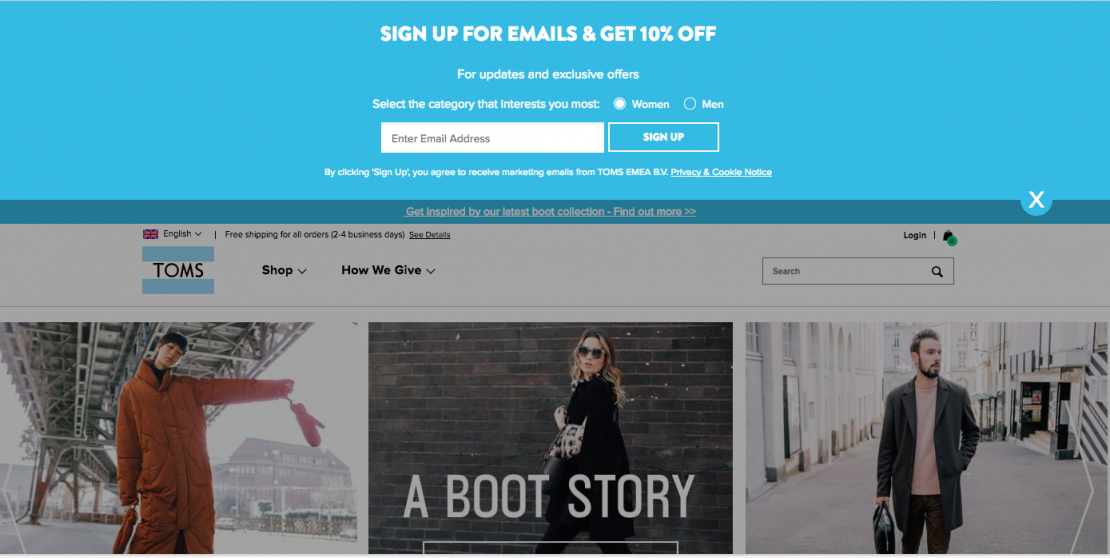
Some things to consider…
- Testing to find the right incentive is essential for margin preservation. One Yieldify client tested 20% vs 25% off for new users and found that the lower incentive actually gave them the same number of leads and incremental revenue.
- For visitors who are already showing intent to purchase with items in the basket, this presents an opportunity to upsell, particularly if they’re dwelling on a page. For example, you could offer a discount on orders over a certain price.
The VIP track
Discounts, while being very effective, aren’t necessarily the only valuable incentive out there to utilize for customer database growth. Many customers find value in being in-the-know.
Kiehl’s, a long-established brand with a passionate following, makes use of its email sign-up message to underline the exclusivity of signing up to the Kiehl’s email list. It hints at discounts without going into specifics, focusing instead on the VIP treatment:
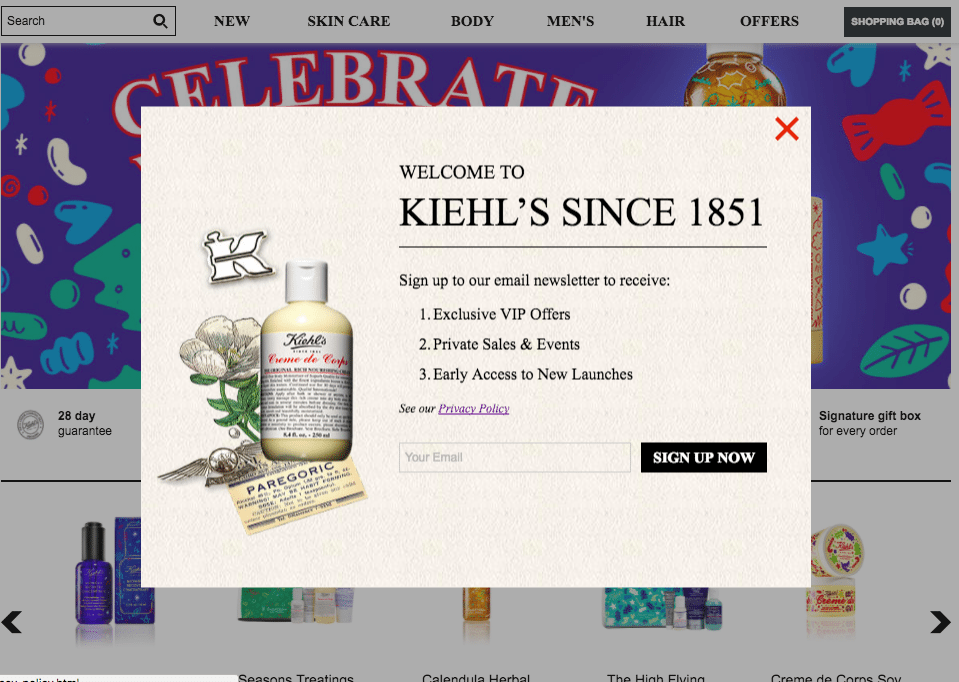
Some things to consider…
- Do you have the operational capacity to manage early access, private events and sales?
- Are people passionate enough about your brand to be enticed by becoming a VIP?
The content upgrade
Depending on your product and your audience, some free content might be the ideal incentive. For example, Really Good Stuff, a retailer selling classroom supplies for teachers, offers an eBook targeted to specific audience segments.
The format of the pop-up also allows the business to collect two pieces of information: both email address and marketing segment, which provides an excellent basis for sending targeted emails:
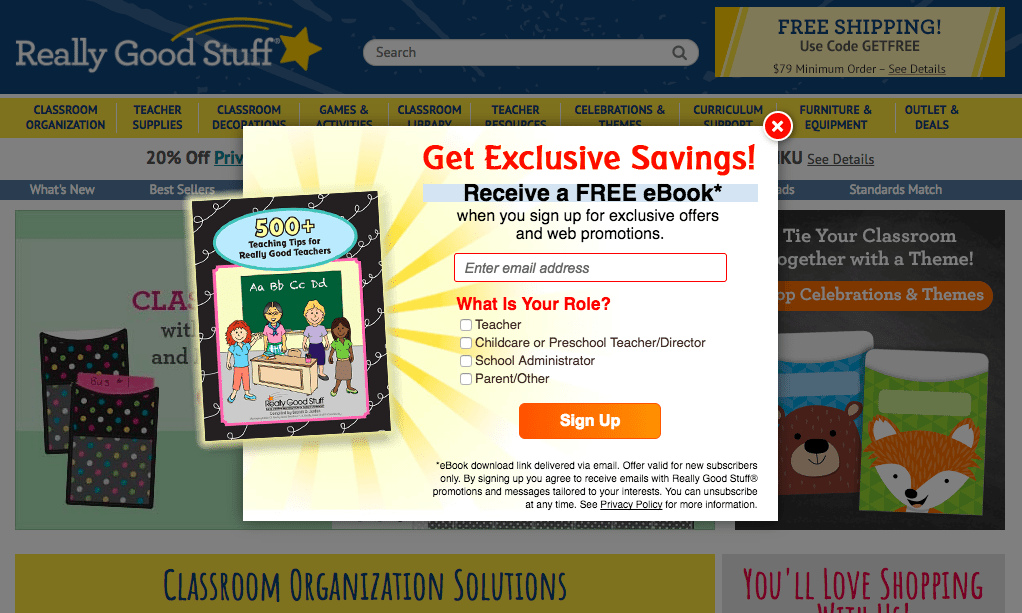
Some things to consider…
- What content would attract your audience?
- Do you have the resources to create a valuable piece of content?
Other non-financial incentives
While discounts may be the most obvious incentive to drive customer database growth, you might not have to take a financial hit in order to acquire an email. We’ve seen that 5% of users will exchange an email for entry into a competition and 4.3% will after being made aware that free delivery is available. It’s time to get creative and test, test, test.
Some things to consider…
- Do your customer persona research to find out what interests, motivations and demographics best represent your target customers.
- When choosing an incentive, it’s essential that your website builder enables you to run A/B testing to find the messaging that resonates the most with new users.
What to do next
Needless to say, there’s no point in investing in customer database growth to acquire leads unless you put your shiny new email addresses to good use. Coming up with a great email marketing strategy could fill a whole guide on its own, so we’ll just leave you with some top tips:
- Once a user has submitted their email, make sure to send them a welcome email straight away to give them a complete experience (you can do this by making sure you have a smooth integration with your ESP). We’ve seen this simple tactic increase conversion by 5%.
- Send automated, personalized emails based on user behavior – in 2015, a study found that segmented, personalized emails account for 58% of all email-generated revenue.
- When designing your emails, use an HTML button as your call to action instead of a text link: this simple step can increase conversion rates by as much as 28%.
- Sending four emails in a month instead of one has been found to significantly increase the number of consumers opening more than one email.
Personalized emails have been found to have 29% higher unique open rates and 41% more unique click-through rates than those that didn’t.
Customer Database Growth: In Conclusion
The art of the lead generation CTA is a tricky one to master: it can be endlessly tailored and tinkered with and involves a lot of testing. But it’s worth it: instead of losing potential customers to the depths of the internet, you can hang on to them, guide them into your funnel, and ultimately convert many of them into making purchases.
Keep the following in mind and watch your customer database growth skyrocket:
- Not every incentive has to be a discount – there are other ways to get visitors to become subscribers.
- Segment your website visitors and tailor your approach to their intent and their behavior.
- Be mindful of your customer journey when balancing your email. capture CTAs with your purchase CTAs – a smart segmentation strategy will help you with this.
- Test, test, and test again!
To get started, why not check out how the Yieldify Conversion Platform can help you grow your database from your existing traffic? Book a free demo to learn more.